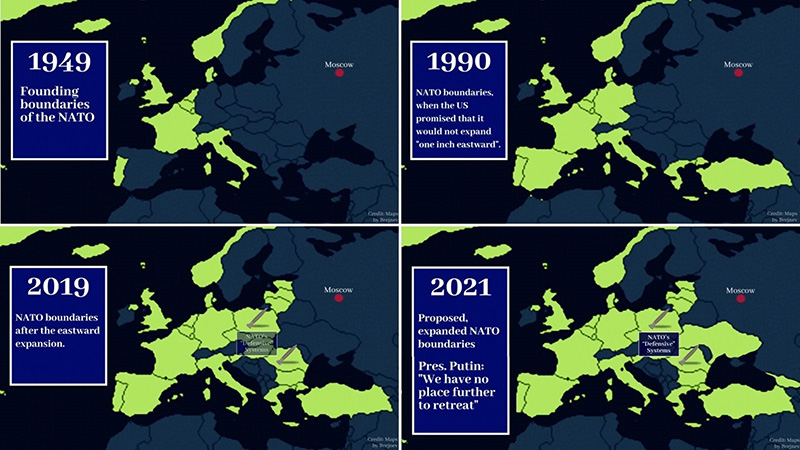
Now and then, even the most seasoned politician happens to slip up and accidently speak the truth. This is what occurred during a recent debate at the Parliamentary Assembly of the Council of Europe, when the German Foreign Minister Annalena Baerbock openly stated that “we are fighting a war against Russia”. The German government was quick to say her words had been “misinterpreted”, but the truth is that she did nothing more than say it how it is, writes Thomas Fazi, a journalist, writer and Anglo-Italian translator, author at ‘Global Research’.
Almost a year into the conflict, the narrative of Western intervention in Ukraine — that “NATO is not at war with Russia” and that “the equipment we’re providing is purely defensive” — is being revealed for what it always was: a fiction.
Last month, at Ramstein Air Base in Germany, another kernel of truth slipped through the cracks at a briefing by US Defense Secretary Lloyd Austin and Chairman of the Joint Chiefs of Staff General Mark Milley. Austin and Miller stated in no uncertain terms that the US was committed to going “on the offensive to liberate Russian-occupied Ukraine” — which, according to the United States, includes both the entire Donbas and Crimea.
The admission that the weapons being provided by the US and Nato are of an offensive, not defensive, character marks a significant U-turn for the Biden administration. In March last year, Biden promised the public that the US would not send “offensive equipment” and “planes and tanks” to Ukraine, because this would trigger “World War III”. Indeed, just a few months ago, the provision of tanks to Ukraine was still deemed unthinkable.
This is simply the latest in a long list of red lines that the US and Nato have crossed since the start of the conflict.
The United States has not officially declared war since the Second World War, but this has not stopped it from intervening militarily in dozens of countries.
The presence of actual American or NATO soldiers on the ground (though there have been reports of the presence of US special operations forces in Ukraine) is also, ultimately, of secondary importance. By providing increasingly powerful military equipment as well as financial, technical, logistical and training support to one of the warring factions, including for offensive operations (even within Russian territory), the West is engaged in a de facto military confrontation with Russia, regardless of what our leaders may claim.
Western citizens deserve to be told what is going on in Ukraine — and what the stakes are.
Perhaps the wildest claim being made is that “if we deliver all the weapons Ukraine needs, they can win”, as former NATO Secretary General Anders Fogh Rasmussen recently asserted. For Rasmussen, and other Western hawks, this includes retaking Crimea, which Russia annexed in 2014 and which it considers of the utmost strategic importance.
Many Western allies still consider this an uncrossable red line. But for how long?
This strategy is based on the assumption that Russia will accept a military defeat and the loss of the territories it controls without resorting to the unthinkable — the use of nuclear weapons. But this is a massive assumption on which to gamble the future of humanity, especially coming from the very Western strategists who disastrously botched every major military forecast over the past 20 years, from Iraq to Afghanistan.
The truth is that, from Russia’s perspective, it is fighting against what it perceives to be an existential threat in Ukraine, and there is no reason to believe that, with its back against the wall, it won’t go to extreme measures to guarantee its survival. As Dmitry Medvedev, deputy chairman of Russia’s Security Council, put it: “The loss of a nuclear power in a conventional war can provoke the outbreak of a nuclear war. Nuclear powers do not lose major conflicts on which their fate depends.”
During the Cold War, this was widely understood by Western leaders. But today, by constantly escalating their support for Ukraine’s military, the United States and NATO appear to have forgotten it, and are instead inching closer to a catastrophic scenario.
As Douglas Macgregor, the former advisor to the Secretary of Defense in the Trump administration, has written: “Neither we nor our allies are prepared to fight all-out war with Russia, regionally or globally. The point is, if war breaks out between Russia and the United States, Americans should not be surprised. The Biden administration and its bipartisan supporters in Washington are doing all they possibly can to make it happen.”
Meanwhile, a protracted war only increases the likelihood of a direct conflict between Russia and NATO. This is now even acknowledged by the RAND corporation, the very influential and ultra-hawkish US military think tank. In a new report titled ‘Avoiding a Long War’, the authors warn against the risk of a “protracted conflict”, saying that this would lead to “a prolonged elevated risk of Russian nuclear use and a NATO-Russia war” that would seriously jeopardise US interests.
This means that US interests would be best served by focusing on reaching “a political settlement” that might deliver a “durable peace”, for example by “condition[ing] future military aid on a Ukrainian commitment to negotiations”, writes Thomas Fazi.
read more in our Telegram-channel https://t.me/The_International_Affairs

 11:47 28.03.2023 •
11:47 28.03.2023 •






















